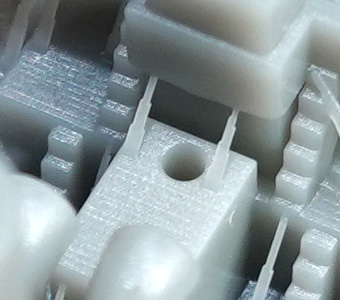 Mast Jig FAQ Mast Jig FAQHow to order for wire sizes not listed – There are so many possible combinations of wire and rod to use for building masts that we have not tried to design all possible jigs in advance. Please email us the wire diameter combinations you need and jigs for those combinations will be added to the store for ordering: webmaster@wtj.com. There are enough different sizes of jigs already available that customers can see in advance approximately what sort of price range their jig is likely to be in. When sending the sizes, provide the diameter of the lower mast, the top mast and the respective yards. Wire sizes should be described in thousandths of an inch (not wire gauge) or millimeters. What do the jig numbers mean? – The numbers represent the diameters of the wire in thousandths of an inch. For the Lower Mast jig, the first number is the diameter of the lower mast (see figure at right) the second number is the diameter of the top mast and lower yard (for our standard jigs we default the top mast and lower yard to the same diameter). So a 45-31 mast has a .045" lower mast pole and a .031" top mast and lower yard. The Upper Yard jig has three numbers; the first two numbers describe the lower mast assembly it is designed to hold and the last number represents the diameter of the upper yard that will be glued to the mast assembly. So an Upper Yard jig 45-31-24 will glue a .024" diameter upper yard onto an existing 45-31 mast assembly. Do I need both jigs? – It depends what you are doing with the models and what scale you are working in. If you are working on larger models for display, you might want a fully configured mast and all the yards and spars. If you are working on smaller models for wargaming, you might only need the primary lower mast assembly (with one yard) to have a perfectly good mast effect. Ultimately it depends on what you want for your ships. Best way to cut wire/rod – We also sell the music wire that can be used to build masts. Music wire is very hard, so the best thing we have found to do the cutting work are 8" bolt cutters made by Kobalt. They cut through any music wire like it's butter (well, really hard butter). How to glue masts together – This is mostly a matter of preference, superglue can be used but it tends to be brittle (but it sets fast). White glue can be used and while it takes time to set, it is durable. Ultimately it depends on the individual user's needs for the models. Tips on using the Lower Mast jig – The lower mast jig will allow you to glue one top mast and one lower yard to the lower mast pole. Start by snipping and deburring the mast wires to the desired lengths (tops and yards should already be to size, as trying to trim them to correct length after gluing may break the mast). Make sure all wire is clean and free of oil or rust. Place them in the V grooves of the jig as shown in the More Info page. Since the wire is often magnetized, use a wooden rod or toothpick to adjust the wire's final position in the fixture. After placing the lower mast last (the lower mast always goes on last, and rests on top of the top and yard) you are ready to glue. Tips on using the Upper Yard jig – The upper yard jig will allow you to glue one upper yard (spar) to the existing mast assembly you built on the lower mast jig. Start by snipping and deburring the upper yard wire to the desired length (yards should already be to size, as trying to trim them to correct length after gluing may break the mast). Make sure all wire is clean and free of oil or rust. Place the yard in the V groove of the jig as shown in the More Info page. Since the wire is often magnetized, use a wooden rod or toothpick to adjust the wire's final position in the fixture. After placing the mast assembly on top of the yard (the mast assembly always goes on last, and rests on top of the yard) you are ready to glue. Average Model Hole Sizes – Most WTJ Naval ships have mast holes already present. The holes increase in diameter as the models are scaled up, the table below shows the most common hole diameters and the ship types most commonly associated with them. Some diameters may vary, and some mast builders choose to drill out the existing holes slightly to install heavier looking masts.
|
|||||||||||||||||||||||||||||||||||||||||

